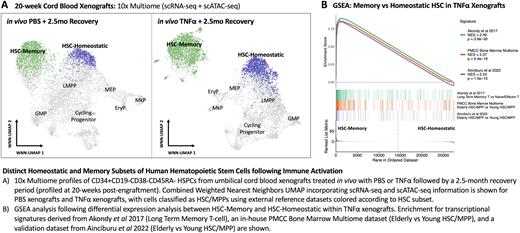Abstract
Long-term hematopoietic stem cells (LT-HSC) are responsible for life-long blood production and show functional erosion due to aging or inflammatory dysregulation. However, the molecular programs underlying aging or LT-HSC responsiveness to emergency hematopoiesis as triggered by stress stimuli, notably inflammation, are poorly understood. We previously identified transcriptional, epigenetic, and functional heterogeneity in human LT-HSC in the transition from quiescence to cellular activation, with inflammatory pathways implicated (Garcia-Prat et al, 2021, Takayama et al, 2021, Kaufmann et al, 2021 and Xie et al, 2021). Here, we observe a gradient of TNFα-via-NFkB pathway enrichment in single cell (sc) transcriptomes of ~4000 cord blood (CB) LT-HSC, suggesting heterogeneous priming for TNFα treatment response within the LT-HSC pool. We asked how inflammation-naive CB HSC respond to and recover from inflammatory stress with a xenotransplantation model challenged either with human TNFα or lipopolysaccarides (LPS) to mimic bacterial infection. Acute TNFα or LPS administration disrupted human CD45 engraftment relative to controls within 16 hours of treatment of fully repopulated recipients. However, engraftment was restored to control levels after a two-week recovery period following inflammatory stress induction. Remarkably, xenografts treated with two single doses of TNFα or LPS at 2w and 10w post-transplantation resulted in significantly reduced human grafts at 20w with highly dysregulated lineage differentiation profiles compared to controls. Thus, long-term effects of acute inflammatory stress persist in human HSCs following a 2.5 month recovery period.
To mechanistically interrogate the impact of immune activation on human HSCs, CD34+CD38-CD45RA-CD19- cells were isolated from control, TNFα, and LPS treated xenografts, after the 2.5 month recovery period at 20w, and subject to joint scRNA-seq and scATAC-seq profiling through the 10x Multiome platform. Within cells classified as HSCs/multipotent progenitors (MPPs), we identified two transcriptionally and epigenetically distinct subsets: homeostatic HSC (HSC-H) and memory HSC (HSC-M). HSC-H are enriched for canonical HSC programs we previously identified, that are involved in and actively sustain the human graft, whilst HSC-M primarily reside outside the trajectory of hematopoietic development (Fig A). Differential expression (DE) and differential accessibility (DA) analysis revealed that HSC-M cells experienced dramatic changes between PBS and TNFα treatment pertaining to gene expression (134 DE genes), chromatin accessibility (5660 DA peaks), and enrichment for transcription factor (TF) binding sites (116 TFs). By contrast, HSC-H cells experienced minimal changes between PBS and TNFα treatment (35 DE genes, 379 DA peaks, 13 TFs). We observed similar trends when comparing PBS and LPS treatments. In particular, binding sites of TFs within the AP-1 complex are enriched in HSC-M versus HSC-H, with the magnitude of this enrichment being more pronounced following TNFα or LPS treatment. Notably, a transcriptional signature specific to long-lived human memory T cells following yellow fever vaccination (Akondy et al, 2017) was highly enriched in HSC-M versus HSC-H cells following inflammatory stress (Fig. B). Additionally, human bone marrow HSC signatures enriched in elderly (70-80y) compared to young (20-30y) donors (generated from in-house scMultiome profiles and validated with scRNA-seq data from Ainciburu et al, 2022) were also enriched in HSC-M versus HSC-H cells isolated from our immune activation xenotransplantation model (Fig. B). Further, an HSC-M-specific transcriptional signature is capable of stratifying human HSCs by age, wherein CB HSCs show the lowest HSC-M signature enrichment and HSCs from older donors (>50y) show the highest HSC-M signature enrichment (50s vs 20s classification AUC = 0.95; 70s vs 20s classification AUC = 0.80). Our mechanistic multiome data points to a set of transcription factors and epigenetic determinants that represent candidates for encoding memory at the HSC level. Overall, these studies point to the discovery of a novel memory HSC pool that may potentially link infection history to human aging, with translational implications of HSC as sensors of inflammatory activation in age-related clonal hematopoiesis and origin of leukemogenesis.
Disclosures
Dick:Graphite Bio: Membership on an entity's Board of Directors or advisory committees; Trillium Therapeutics/Pfizer: Patents & Royalties: patent licencing; Celgene/BMS: Research Funding.
Author notes
Asterisk with author names denotes non-ASH members.


This feature is available to Subscribers Only
Sign In or Create an Account Close Modal